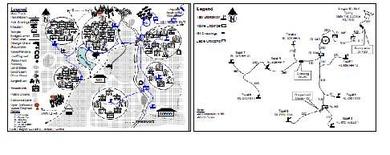Tool 7
TOOL 7. COMMUNITY MAPPING
To obtain an overview of water resources and infrastructure in the community, and sites where water is used.
OBJECTIVE
To obtain an overview of water resources and infrastructure in the community, and sites where water is used.
METHOD
This exercise can be done with the whole community, or with a number of focus groups, including men and women, different water users or different wealth groups (which can be identified using Tool 3), or any other grouping deemed relevant.
Step 1: Start drawing a community map
The facilitator invites the participants to draw a map of the community and its surroundings, identifying:
- Reference points, such as roads, buildings, etc.
- Water resources being used by the community.
- Water infrastructure, such as wells, dams, boreholes, even ones that are not being used anymore.
- Sites where water is being used, such as homesteads, gardens, cattle dips, etc.
- If possible, identifying where different user categories are living.
Figure 5 Examples of community maps

Source: WARM-P/Helvetas and RVWRMP, 2007
Step 2: Analysis
The participants analyse the implications of this map, guided by questions from the facilitator, including:
- What are your observations with respect to availability of water resources?
- What are your observations with respect to the use of these resources?
- Is there a relation between water sources, infrastructure and the location of users?
- What are implications for development of further infrastructure for multiple uses?
Step 3: Verifying the community map
- The participants of different groups present their map and analysis results to each other. Based on this, one final map will be drawn. In order to do so, agreements within the groups will be taken as an accord. Where the two groups have identified different objects or points of analysis, these will be discussed until agreement is reached.
ALTERNATIVE / ADDITION: USING COMMUNITY MAPPING TO COME TO A COMMUNITY-LEVEL MUS VISION
In addition to providing a good view of the current situation, this tool can also be used to establish a vision of MUS at community level. In that case, when drawing a map of the community, the participants do not show multiple uses of water in reality, but how they would like their community to be in future in terms of multiple uses of water and multiple use services.
In order to do so, tell people at the start of the exercise that you would like to know what they consider to be a wonderful village, with relation to water services and water use. Stress that you would like them to make a map that depicts the ‘village of their dreams’, not as it is now.
Ask them to first take a few minutes to dream and talk about it, whereby they also dream about their community in relation to the surrounding area. To facilitate the dreaming you may ask questions such as:
- If you were to rebuild the water infrastructure in your community, what would it look like?
- If you were to change the use of water within the community, what would you change?
- What kind of improvements would you like to see that solve existing problems?
Discuss the results by asking the group(s) to explain what they have drawn and list the major differences with the community as it is now. If the tool has been used with various smaller groups, compare the results and discuss the differences and similarities.
Wind up the meeting by asking how the information from the map can be used in the near future.
TIPS AND TRICKS
- This exercise can be done using paper and pens, or by using local materials, like sticks, stones and leaves.
- Give people ample time and opportunity to draw their map and take care not to guide them.
- Take a picture of the map for future reference and leave the actual map with the community.
- Verification can be done by doing a village walk (see Tool 8).
BASED ON
Tool 4 in: ZIMWASH, 2010.Guidelines for Planning for Water for Livelihoods, Harare: ZIMWASH Project
Tool 2 in: Smits, S. and Mejía, T., 2011. Guía para la Planificación e Implementación de Proyectos de Usos Múltiples del Agua, The Hague / Tegucigalpa: IRC/ RASHON
Tool 5 in: Bolt, E. and Fonseca, C. (2001). Keep it working: a field manual to support community management of rural water supplies,Technical paper series, IRC; no. 36, Delft: IRC International Water and Sanitation Centre.
Tool 21 in: Bolt, E. and Fonseca, C. 2001. Keep it working: a field manual to support community management of rural water supplies,Technical paper series, IRC; no. 36, Delft: IRC International Water and Sanitation Centre.
